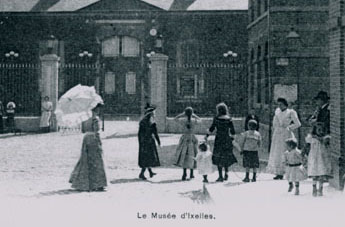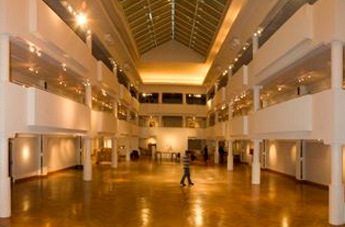History
The Museum of Ixelles was founded in 1892 as a result of a significant donation of artworks made by the painter and collector Edmond De Pratere (1826-1888). In return, the commune of Ixelles committed itself to exhibiting the work in a place accessible to the public. A disused slaughterhouse was chosen and converted to suit its new function. To the present day, it still houses the museums’ permanent collection.
The new museum caused much excitement. Collections increased and a communal budget was created for the acquisition of works of art. At the same time, generous donations and legacies enriched the collections. The most significant among them were those of lawyer and patron of Brussels art, Octave Maus (1856-1919), which accounts for more than 200 impressionist, neo-impressionist and symbolist works.
Several directors made their mark throughout the museum’s history.
From 1958 Jean Coquelet established a dynamic cultural policy by organising regular and exemplary temporary exhibitions: Rene Magritte (1959), Leon Spilliart (1961), Victor Servranckx (1965), Oscar Jespers (1966), Paul Delvaux (1967), Félicien Rops (1969), Henri de Toulouse-Lautrec (1973), The Maeght Foundation (1975), The collection of Thyssen-Bornemisza (1977), The Spitzner Museum (1979), An Homage to Pierre Loeb (1979) as well as Alfons Mucha (1984).
Thanks to this enlightened management, the museum itself required considerable attention. In 1973, construction of a new wing proved essential and brought forth a reception hall, two large temporary exhibition halls and a vast storeroom.
Nicole d’Huart took over from Jean Coquelet in 1987. Temporary exhibitions remained one of the main activities of the museum. Worthy of note are the following: Art Deco Belgium (1988), Shunga, Japanese erotic prints (1989), Impressionism and Fauvism in Belgium (1990), Turner in Europe (1992), Sigmund Freud, Art and archaeology (1993), Gainsborough with Ruskin (1994), George Lemmen (1997), Russian Avant-Garde (1998), Victor Hugo, artist (1999), Die Brucke (2000), Colour Rebellion, the Carmen Thyssen-Bornemisza Collection (2001), Paris 1900 (2002), the Simon Collection (2003), Russian Symbolism (2006) and finally the Collection of Passion, Passion of Collection (2007).
In 1994, the commune of Ixelles made the jubilant decision to assign the sizeable plot adjacent to the Museum, known as the Village Hall, as exhibition space. Encouraged in this venture by the patronage of the J.P. Morgan Bank, the latter financed a large part of the restoration costs. Thus, a thousand square metres came to be added to the existing exhibition areas, which today form the hall and temporary exhibition room of the museum.
Claire Leblanc, present director, followed on from Nicole d’Huart in 2007. Numerous temporary exhibitions ensued: All Roads Lead to Rome, Voyages of Artists from the 16th to the 19th Century (2007-8), Black Paris, Black Brussels; Art and History of the 1906 Diaspora to the present day (2008), A Belle Epoque Summer, Alexandre Charpentier, Naturalism and Art Nouveau (2008), One For The Other, Writers Who Draw (2008-2009), Brussels, Land of Convergence (2008-2009), Paul delvaux. A selection of works on paper (2008-2009), Steinlen, the Eye of the Street (2009), Fading (2009), La photographie n'est pas l'art. Sylvio Perlstein Collection (2009-2010), Les peintres de la Forêt de Soignes. Jardin de Bruxelles (2009-2010), El Cubismo. Cubism and its context (2010), from the Fundacion Telefonica Art Collection, Close-up (2010), Collection of Photographs from the Museum of Ixelles (Summer of Photography) Photographer Laurent Friob (2010), 10 Years of Acquisitions (Museum of Ixelles's collection- 2010), From Dürer to Jan Fabre: Masterpieces (2010-2011), Paul Delvaux. Starting Points (2010-2011), Discover Each Other Trough Water (2010-2011), Annabella Guetatra - Jens Hesse - Award Marie-Louise Rousseau 2010 (2010-2011), Olivier Debré. Lyrical abstracts. Retrospective (2011), Explosition, Brussels Graffiti Art (2011), Non, pas ce soir. The publishing house la trame celebrates its 10th anniversary (2011), Dubuffet architect (2011-2012), Pierre Lahaut. Hommage (2011-2012), Paul Delvaux, sculptor (2011-2012).
Thanks to a purchasing policy made possible due to the commune and the Friends of the Museum, like the donations and legacies of the past, the Museum of Ixelles today houses an eclectic collection. It stands as testimony to the artistic calling of a multi-disciplinary museum open to all forms of creativity, and one in which the 19th and 20th centuries are especially represented.
Its collections currently stand at more than 13,000 pieces including works by Gaston Bertrand, Paul Delvaux, Rene Magritte, Berthe Morisot, Constant Permeke, Pablo Picasso and Henri Toulouse-Lautrec. For this reason, you will find various realist works, impressionist, luminist, neo-impressionist and symbolist; as well as other artists inspired by fauvism, expressionism, cubism, surrealism and abstraction. To further enrich, there is a robust collection of beautiful works by the Flemish Masters. The collection also includes works that are representative of the foreign schools and a remarkable collection of ‘fin de siécle’ posters including a complete set of Toulouse-Lautrec originals.
Document Actions





